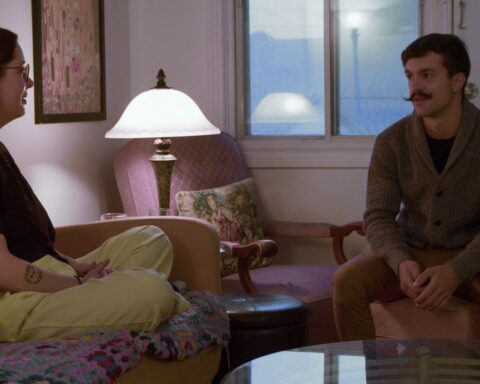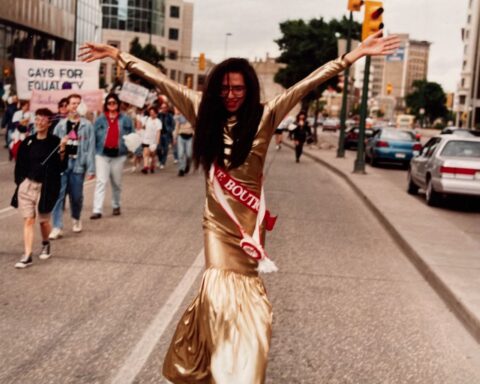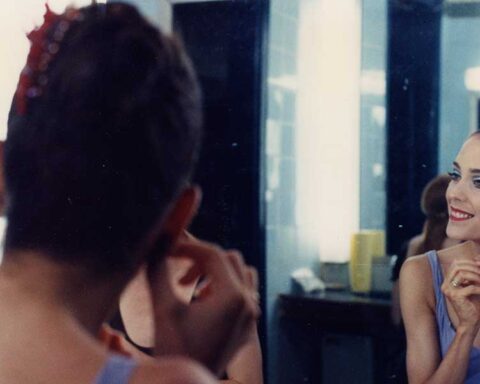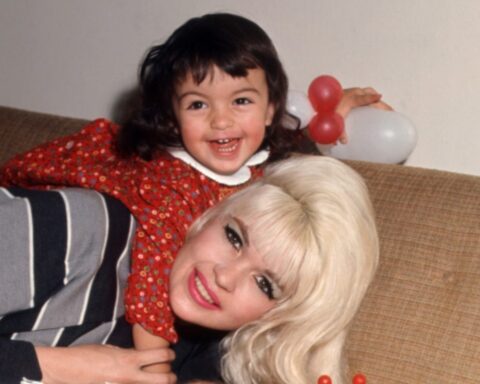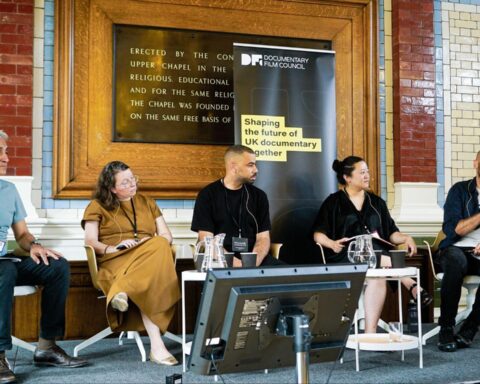In May, 2008 a woman named Gigi left a message on my Florida voicemail. I was doing a documentary about hourly motels on SW 8th Street in Miami, also known in Spanish as Calle Ocho, the main road through Little Havana. She said that she had seen my ad in Taboo magazine seeking interviews with couples, johns and escorts and that’s why Gigi had called. I knew immediately that I wanted to interview her—she was articulate, frank and thoughtful. I offered to pick her up and drive her home, and she readily accepted.
Gigi was a dramatic person. She was a short, overweight, platinum blond dressed head-to-to in red. She’d been a phone operator at escort agencies and phone sex provider for many years, and she had a gift for description and pauses.
Gigi told us about the first time she exchanged sex for money, about her relationship with her parents and siblings, and her sense of herself. She told us what men and women wanted when they came to her. She didn’t consider it cheating when a married person paid for sex, but she was emotionally exhausted by the work. She was too old and too fat and business had dried up.
I had begun filming this documentary about ‘a week in the life’ of an hourly motel in December 2006. It took 16 months and, at last with Gigi, I had my breakthrough—an authentic presence willing to talk about sex and life on Miami’s motel strip.
I wanted my documentary to feature an ensemble of voices—of the motel owners, staff and guests. Now when I look back, I can see that although I had permission from them to film in the motel, that was not the same thing as access. The staff of the motel were reluctant to say anything because they didn’t want to lose their jobs.
The owners were deeply ambivalent about participating in the documentary because I suspect they were deeply ambivalent about being in the hourly motel business.
The motels were protected by a code of silence in Latin American culture. Everyone practiced a studied indifference—inside the motel, as they crossed the parking lot or stood in the office, and outside on the street, as the cars drove in and out. I was breaking with a strong cultural tradition. Indeed when I met with a gay Cuban director he laughed at how he’d never thought of making a documentary in a motel himself.
Ask someone about a place like the motel, and what they say will tell you more about them than the place. The motel is a blank slate on which they project their selfimage, culture and prejudice. Ask a guest while they are safely cocooned inside the motel room and they’ll tell you excuses, and also sometimes about their pain and longings. They may be so open with you that you’ll love them, and hope that when they leave that place, they will have had some catharsis that will carry them across.
I had entered the world of motels naively. I was working for documentary veteran Michael Maclear who had sent me to Miami to secure the participation of Fidel Castro’s estranged daughter Alina in a doc he was developing about the future of Cuba after Castro. Michael gave me permission to be creative in my suggestions of locations to film. When Alina pointed to the motels we were passing and said casually, “these motels look like ordinary motels but they have mirrors on the ceiling and rent rooms by the hour,” I made note. There are 20 motels on Eighth Street and according to my research, 19 of them rent rooms by the hour. When Michael did not include the motels in his treatment, I asked him if he would mind if I tried to develop a documentary about a motel, and he gave me permission.
What intrigued me about the motels was that there were many of them and they weren’t peripheral to the city, they were on a main east-west thoroughfare. I researched the history of the motels: the road was the old highway across southern Florida. The motels were built after WWII to accommodate tourists driving to Miami Beach. Business declined as people started flying to Miami Beach and, in the 1970s, the motels began to rent by the hour.
Hourly motels are common and well developed in Latin America. Rooms have private garages with curtains or doors to conceal the cars, and private staircases. The motels in Miami went through a similar transformation when owners began tearing down the old 1950s era buildings and replacing them. The motel I was filming in was rebuilt in 1994 and the owner was adding a new wing of Jacuzzi suites while we filmed.
It was the busiest motel on the strip, two short blocks from downtown Miami and the banking district, next to an I-95 exit. It was clean, the rooms were nice, and it didn’t charge any more than its skanky competitors. It was well staffed with a desk clerk, two maids and a laundrywoman on duty most of the time, so it felt inhabited and supervised.
I saw the Cuban-American owners applying American values of quality, service and price to a sex motel, and I thought that was funny, respectable and interesting given America’s conflicted relationship with sex.
Months before I met Gigi, I organized what was supposed to be my principal photography shoot. I moved into the motel with a crew thinking that people would get used to us if we were there for a month. We had the owners’ permission to put a notice card in all the motel rooms and the office, telling people what we were doing and asking them to call or email if they were interested in learning more or giving us an interview.
What happened instead was the guests stopped coming. I placed a Cuban- American production coordinator in the office to hand out cards directly to the guests as they checked in or returned keys, but, as she handed them out, she looked at the guests over her glasses as if she was inviting them to share in an inside joke. The only times we got interview subjects that way was when I was in the office with her, and could reiterate that we were serious and non-threatening.
Business continued to decline, and each week the owners became more alarmed and reduced our access to the public spaces in the motel. At the two week mark, I contemplated pulling up stakes and coming home. I should have taken the cards out of the rooms.
I asked the owners and staff to introduce our project to guests that they thought would be interesting interviews, but that yielded little.
We left at the end of that shoot with five interviews. We’d driven so much business away from the motel, the owners said it took three months for the numbers to recover. When I called the patriarch to ask permission to return he said, “Let me tell you something: No.” And then he went on at some length in heavy Cuban Spanish delivered at high speed, and he was in no mood to slow down.
When the footage we had with family and staff was translated and subtitled, it was clear how weak the material was and how much of the narrative was going to rest on my writing. Even then I would have to do pick up shooting.
My parents happened to be planning a trip: my mother said, “We’re either going to go to Emo and burn brush piles at the cabin, or we’re going to drive to Florida.” I said, “If you go to Florida, you could really help me out.” They drove to Florida and after visiting friends, checked into the motel, and stayed for two nights. The owners took them to dinner, and gave them one night’s accommodation free, which was all my parents would accept. My parents and the owners had something in common: they had all grown up on farms, and through an interpreter, they talked about agriculture and Cuba.
I said to my father, on the phone the first morning, “Isn’t the motel nice?” and he said, “Yeah … It’s a little plain. There’s no place to put your luggage.”
I paused and added, “Dad, most people don’t bring luggage.”
Silence. He started to chuckle.
Not long after that, I flew to Florida and ambushed the principal owner and asked him for another chance to film in the motel. This time he said yes, but if I slipped up once, he would throw me out.
By the time I was ready to return for my pick up shoot, my editor Dave Kazala, had been through all the footage. We knew its weaknesses and had a clear shopping list of things to make it work, but the owners still weren’t committed to being subjects of the documentary and we didn’t get what needed. It was at that moment, that Gigi called.
What made the difference in finding guest interviews was the approach: instead of asking people for interviews, I began to think of the work as inviting people to tell their stories. This tactic removed a lot of stress for me. I had been self-conscious about my project, worried about what people would think, always eager to defend its merits and deal with that implied prejudice about prostitution. Now, I let go of pre-conceptions and simply offered an invitation. Gigi was the first to respond.
I brought the Gigi tapes back to Toronto, and after a couple of days, Dave said, “you have a choice to make: either we tone her down so that she doesn’t overwhelm the other footage in the film or we let her play at full strength and we change direction.” With principal photography technically finished, I decided to change direction.
We re-placed an ad in the escort magazine, and one in the Miami equivalent of NOW and Eye magazines. We also created a bar flier and had a local bon vivant go around town leaving them in clubs and talking the film up with bartenders and regulars. We received 58 inquiries. We booked 16 interviews, and conducted nine. The rest were no-shows. Cadillac, B, Richard, Sara, and Rose became characters in the final film.
The documentary weaves seven voices and an eighth thread of visuals—beauty shots of the motel, hidden camera shots of guests in the parking lot, and shots of the city and the beach—through the length of the feature film. I’ve spoken to most of them in the last few days, to tell them the good news that the film is done and has been invited to the Hot Docs festival. I don’t know why they came forward or why we served as their confessors, but when we talked, I learned that four of them had left some aspects of their old ways of life behind, and three were in love.




